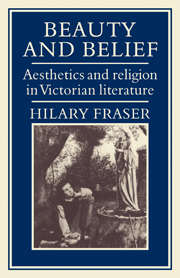Book contents
- Frontmatter
- Contents
- Dedication
- Acknowledgements
- List of abbreviations
- Introduction
- 1 Theology: Keble, Newman, and the Oxford Movement
- 2 Epistemology and perception: Gerard Manley Hopkins
- 3 Criticism: John Ruskin and Matthew Arnold
- 4 Aestheticism: Walter Pater and Oscar Wilde
- Conclusion
- Notes
- Select bibliography
- Index
- Frontmatter
- Contents
- Dedication
- Acknowledgements
- List of abbreviations
- Introduction
- 1 Theology: Keble, Newman, and the Oxford Movement
- 2 Epistemology and perception: Gerard Manley Hopkins
- 3 Criticism: John Ruskin and Matthew Arnold
- 4 Aestheticism: Walter Pater and Oscar Wilde
- Conclusion
- Notes
- Select bibliography
- Index
Summary
In a disapproving essay on Arnold's and Pater's aestheticised versions of Christianity, T. S. Eliot observes that their persistent and, in his view, misguided identification of art and religion is highly representative of ‘one moment in the history of thought and sensibility in the nineteenth century’:
The dissolution of thought in that age, the isolation of art, philosophy, religion, ethics and literature, is interrupted by various chimerical attempts to effect imperfect syntheses.
Elsewhere, Eliot locates the central weakness of Victorian poetry in its ‘dissociation of sensibility’: ‘Tennyson and Browning’, he says, 'are poets, and they think; but they do not feel their thought as immediately as the odour of a rose.’ In the essay on Arnold and Pater he suggests that other Victorian intellectuals were similarly engaged in an unrealistic and futile endeavour to reconstruct an irreparably fragmented aesthetic, philosophical, and religious sensibility. The breadth of his indictment may well lead us to perceive an element of special pleading in Eliot's views, but even setting aside the combined prejudices of Catholic and Modernist orthodoxy of which those views are comprised, Eliot has here identified one of the most prominent and characteristic features of Victorian thought: a proliferation of religio-aesthetic theories designed to reconcile the claims of Christianity and beauty, morality and art.
In their desire to relate aesthetic cognition and judgement to religious and moral values, and the Christian faith to aesthetic experience, the Victorians are entirely traditional.
- Type
- Chapter
- Information
- Beauty and BeliefAesthetics and Religion in Victorian Literature, pp. 1 - 6Publisher: Cambridge University PressPrint publication year: 1986



